Foreword / YouTube Video Review
The review on this website is a brief overview and summary of the objective performance of this speaker. It is not intended to be a deep dive. Moreso, this is information for those who prefer “just the facts” and prefer to have the data without the filler.
Information and Photos
The DIYSG HTM-12v1 is a DIY design from Matt Grant which was/is available in kit form from DIYSG.
Note the distinction of this model is “v1” as there has since been an update to this speaker design which was released in early 2020. Therefore, this review is more for educational purposes and hopefully will help users and designers alike understand the objective performance in the highest resolution possible as current available measurements are a mixture of quasi-anechoic methods and thus have low resolution / high smoothing, insufficient to show problematic areas where anechoic measurements excel.
The HTM-12v1 is a 2-way loudspeaker featuring a SEOS-15 waveguide with Denovo DNA-325 and an Eminence Deltalite 12-inch woofer. (These specific parts could be different model numbers; this was the best information I could find and I will update this section if necessary).
A kit for a single speaker (including everything sans enclosure; except for front baffle) was approximately $330.
These speakers were loaned to me by their owner, who built them from the kit. There are no physical or electro-mechanical issues and this unit is a good sample, representative of what one would ideally build from the kit.
CTA-2034 (SPINORAMA) and Accompanying Data
All data collected using Klippel’s Near-Field Scanner. The Near-Field-Scanner 3D (NFS) offers a fully automated acoustic measurement of direct sound radiated from the source under test. The radiated sound is determined in any desired distance and angle in the 3D space outside the scanning surface. Directivity, sound power, SPL response and many more key figures are obtained for any kind of loudspeaker and audio system in near field applications (e.g. studio monitors, mobile devices) as well as far field applications (e.g. professional audio systems). Utilizing a minimum of measurement points, a comprehensive data set is generated containing the loudspeaker’s high resolution, free field sound radiation in the near and far field. For a detailed explanation of how the NFS works and the science behind it, please watch the below discussion with designer Christian Bellmann:
The reference plane in this test is just below the tweeter, per the designer, Matt.
Measurements are provided in a format in accordance with the Standard Method of Measurement for In-Home Loudspeakers (ANSI/CTA-2034-A R-2020). For more information, please see this link.
CTA-2034 / SPINORAMA:
The On-axis Frequency Response (0°) is the universal starting point and in many situations, it is a fair representation of the first sound to arrive at a listener’s ears.
The Listening Window is a spatial average of the nine amplitude responses in the ±10º vertical and ±30º horizontal angular range. This encompasses those listeners who sit within a typical home theater audience, as well as those who disregard the normal rules when listening alone.
The Early Reflections curve is an estimate of all single-bounce, first-reflections, in a typical listening room.
Sound Power represents all the sounds arriving at the listening position after any number of reflections from any direction. It is the weighted rms average of all 70 measurements, with individual measurements weighted according to the portion of the spherical surface that they represent.
Sound Power Directivity Index (SPDI): In this standard the SPDI is defined as the difference between the listening window curve and the sound power curve.
Early Reflections Directivity Index (EPDI): is defined as the difference between the listening window curve and the early reflections curve. In small rooms, early reflections figure prominently in what is measured and heard in the room so this curve may provide insights into potential sound quality.
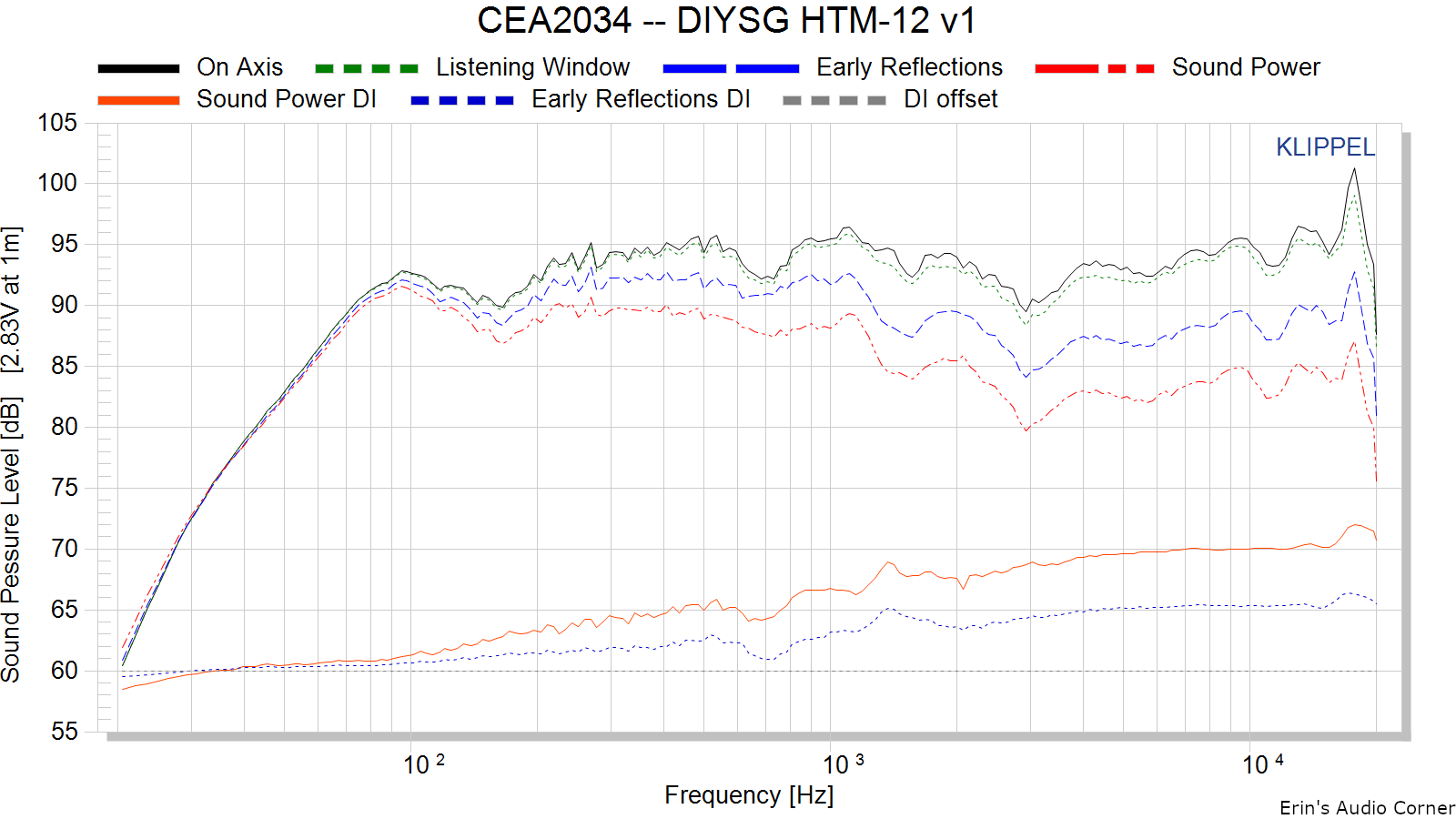
Early Reflections Breakout:
Floor bounce: average of 20º, 30º, 40º down
Ceiling bounce: average of 40º, 50º, 60º up
Front wall bounce: average of 0º, ± 10º, ± 20º, ± 30º horizontal
Side wall bounces: average of ± 40º, ± 50º, ± 60º, ± 70º, ± 80º horizontal
Rear wall bounces: average of 180º, ± 90º horizontal
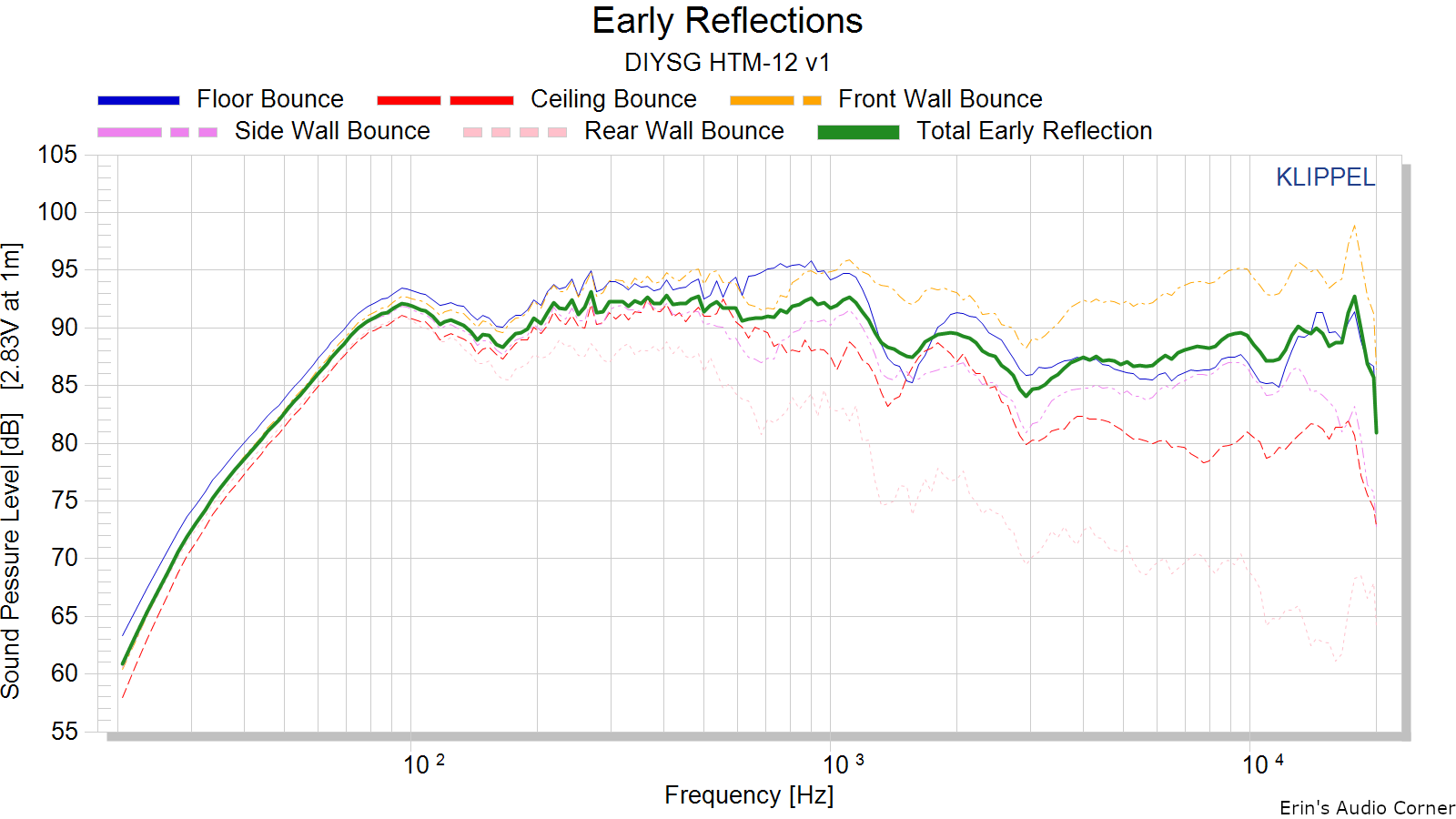
Estimated In-Room Response:
In theory, with complete 360-degree anechoic data on a loudspeaker and sufficient acoustical and geometrical data on the listening room and its layout it would be possible to estimate with good precision what would be measured by an omnidirectional microphone located in the listening area of that room. By making some simplifying assumptions about the listening space, the data set described above permits a usefully accurate preview of how a given loudspeaker might perform in a typical domestic listening room. Obviously, there are no guarantees because individual rooms can be acoustically aberrant. Sometimes rooms are excessively reflective (“live”) as happens in certain hot, humid climates, with certain styles of interior décor and in under-furnished rooms. Sometimes rooms are excessively “dead” as in other styles of décor and in some custom home theaters where acoustical treatment has been used excessively. This form of post processing is offered only as an estimate of what might happen in a domestic living space with carpet on the floor and a “normal” amount of seating, drapes, and cabinetry.
For these limited circumstances it has been found that a usefully accurate Predicted In-Room (PIR) amplitude response, also known as a “room curve” is obtained by a weighted average consisting of 12 % listening window, 44 % early reflections and 44 % sound power. At very high frequencies errors can creep in because of excessive absorption, microphone directivity, and room geometry. These discrepancies are not considered to be of great importance.

Horizontal Frequency Response (0° to ±90°):

Vertical Frequency Response (0° to ±40°):

Horizontal Contour Plot (not normalized):
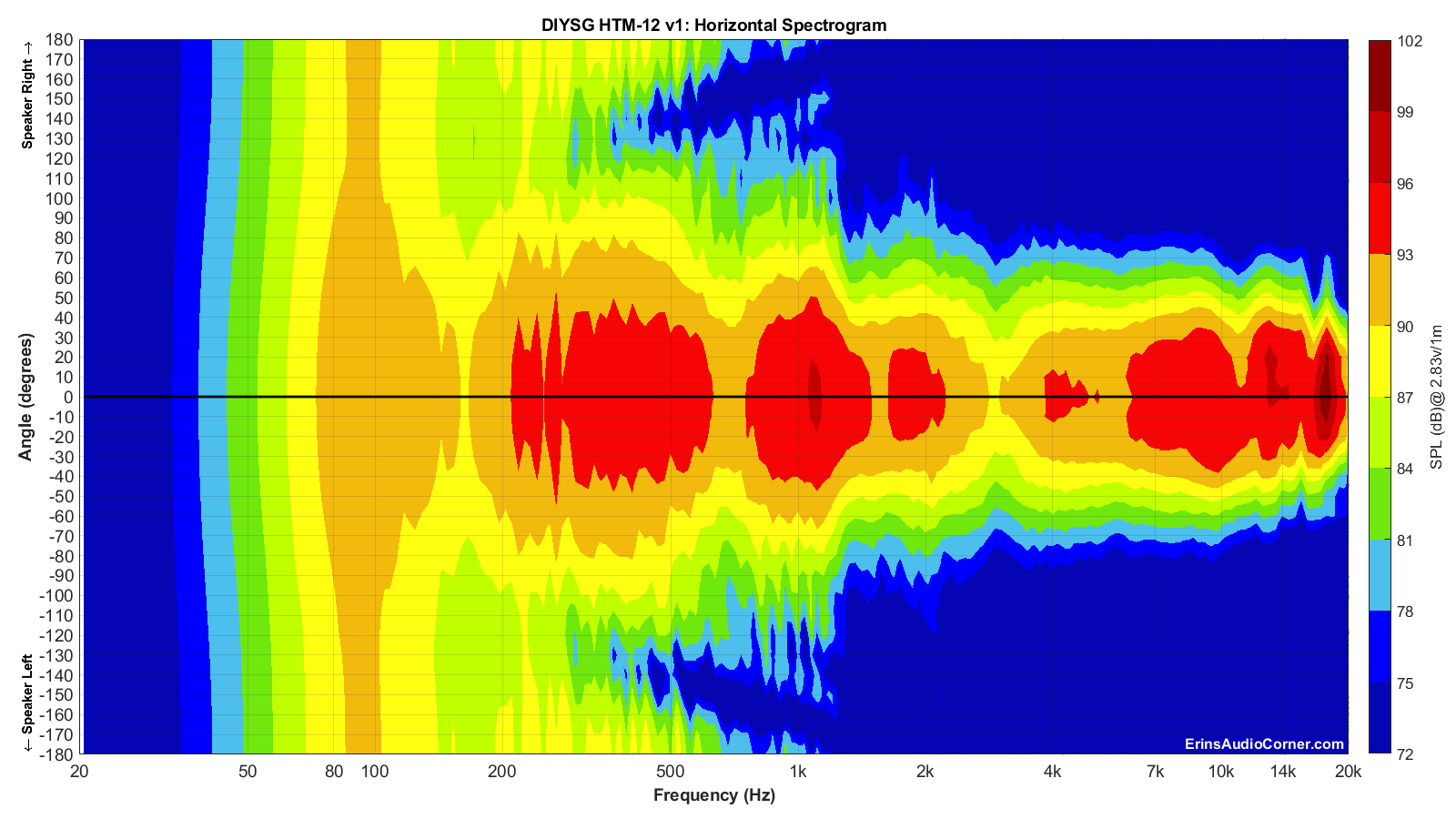
Horizontal Contour Plot (normalized):
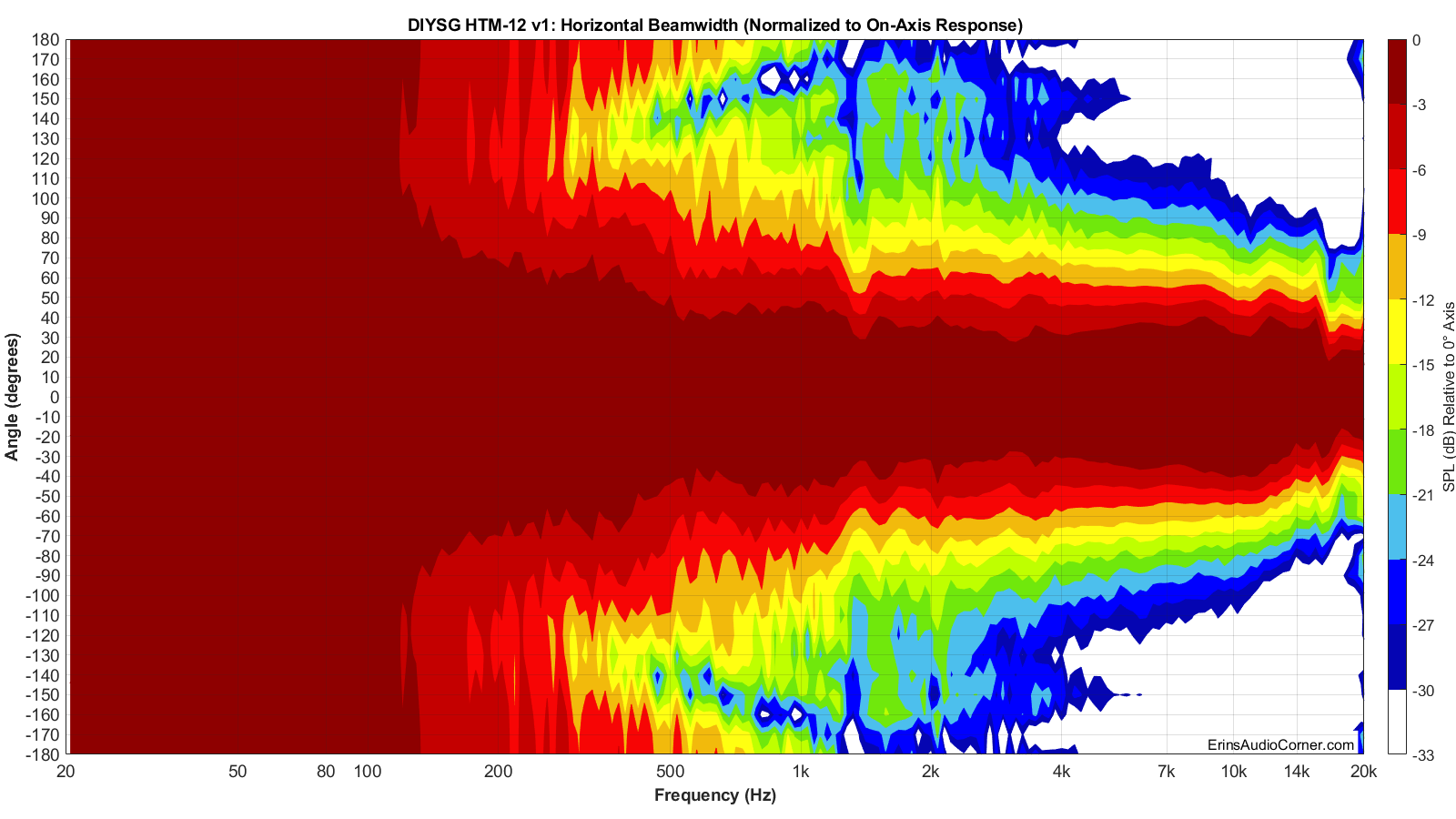
Vertical Contour Plot (not normalized):
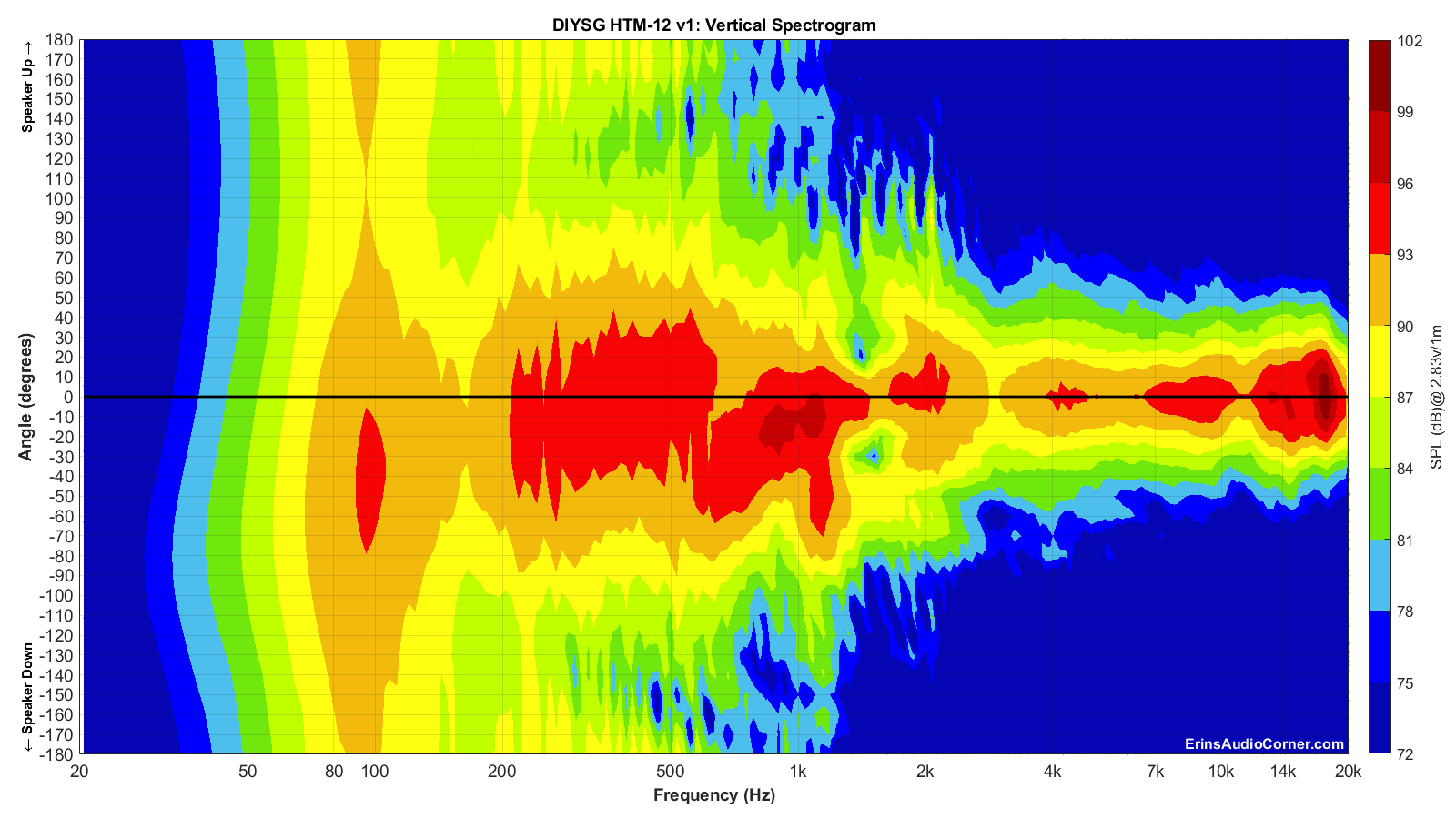
Vertical Contour Plot (normalized):
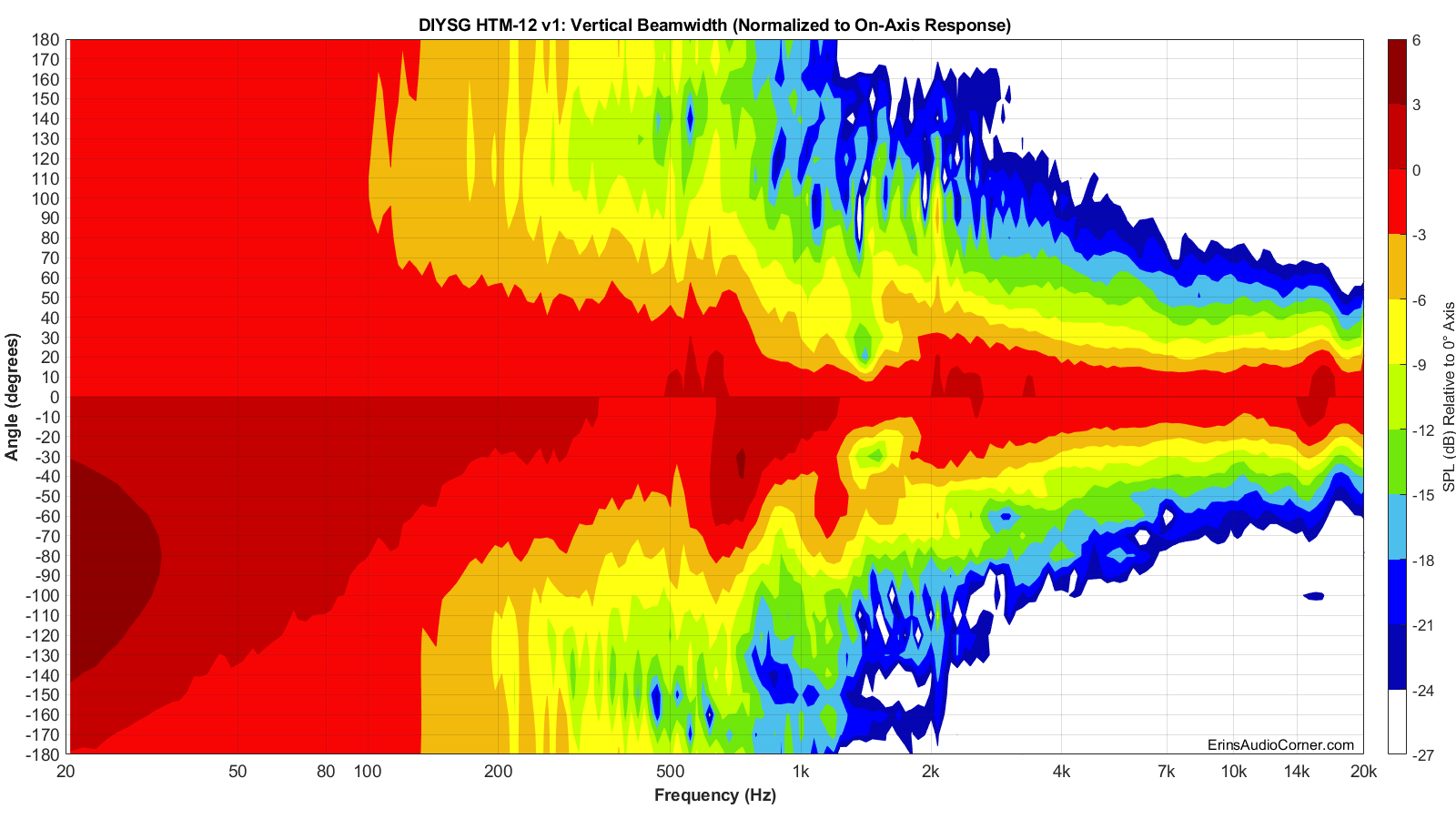
Additional Measurements
Impedance Magnitude and Phase + Equivalent Peak Dissipation Resistance (EPDR)
For those who do not know what EPDR is (ahem, me until 2020), Keith Howard came up with this metric which he defined in a 2007 article for Stereophile as:
… simply the resistive load that would give rise to the same peak device dissipation as the speaker itself.
A note from Dr. Jack Oclee-Brown of Kef (who supplied the formula for calculating EPDR):
Just a note of caution that the EPDR derivation is based on a class-B output stage so it’s valid for typical class-AB amps but certainly not for class-A and probably has only marginal relevance for class-D amps (would love to hear from a class-D expert on this topic).

On-Axis Response Linearity

“Globe” Plots
These plots are generated from exporting the Klippel data to text files. I then process that data with my own MATLAB script to provide what you see. These are not part of any software packages and are unique to my tests.
Horizontal Polar (Globe) Plot:
This represents the sound field at 2 meters - above 200Hz - per the legend in the upper left.
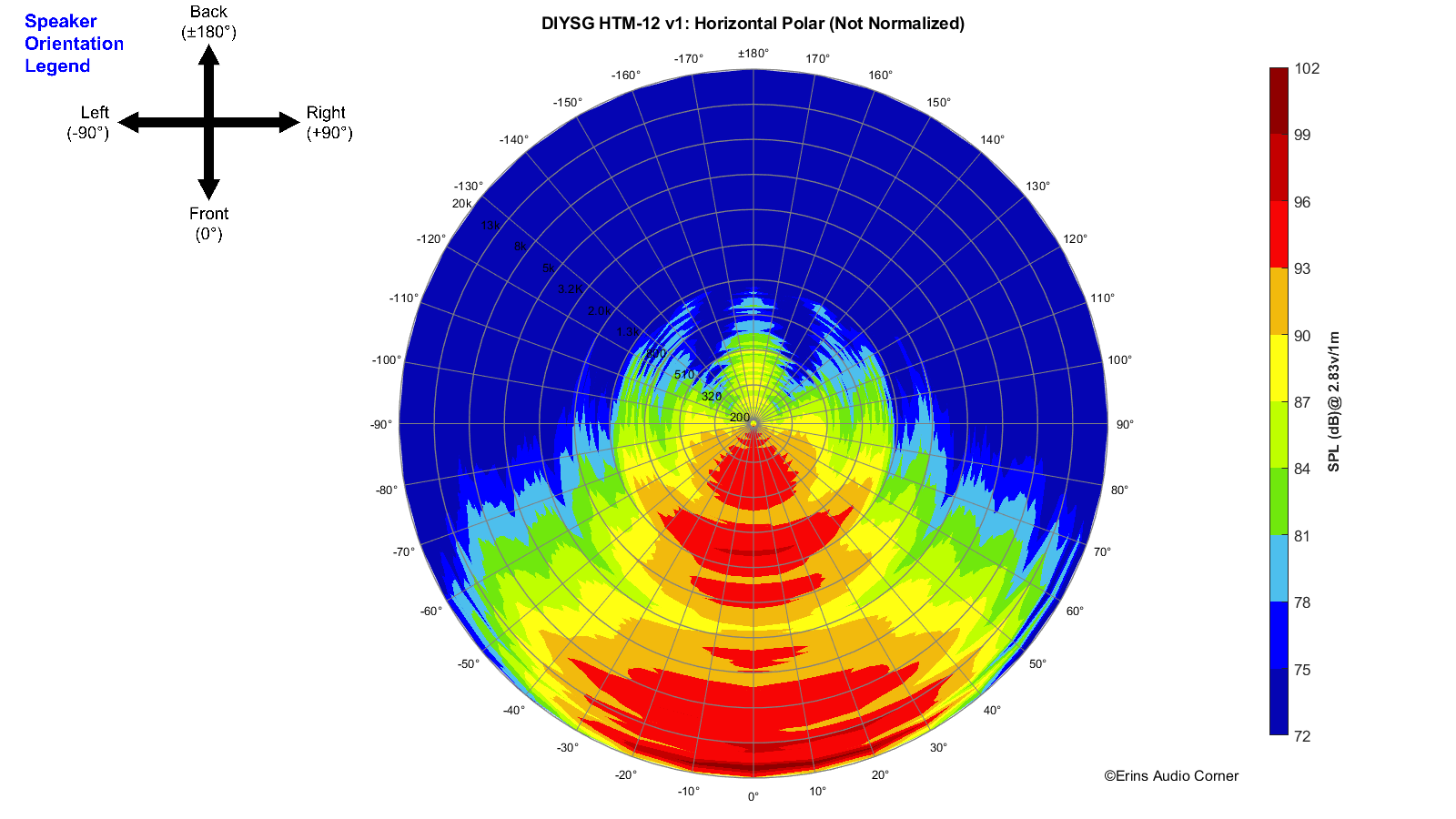
Vertical Polar (Globe) Plot:
This represents the sound field at 2 meters - above 200Hz - per the legend in the upper left.
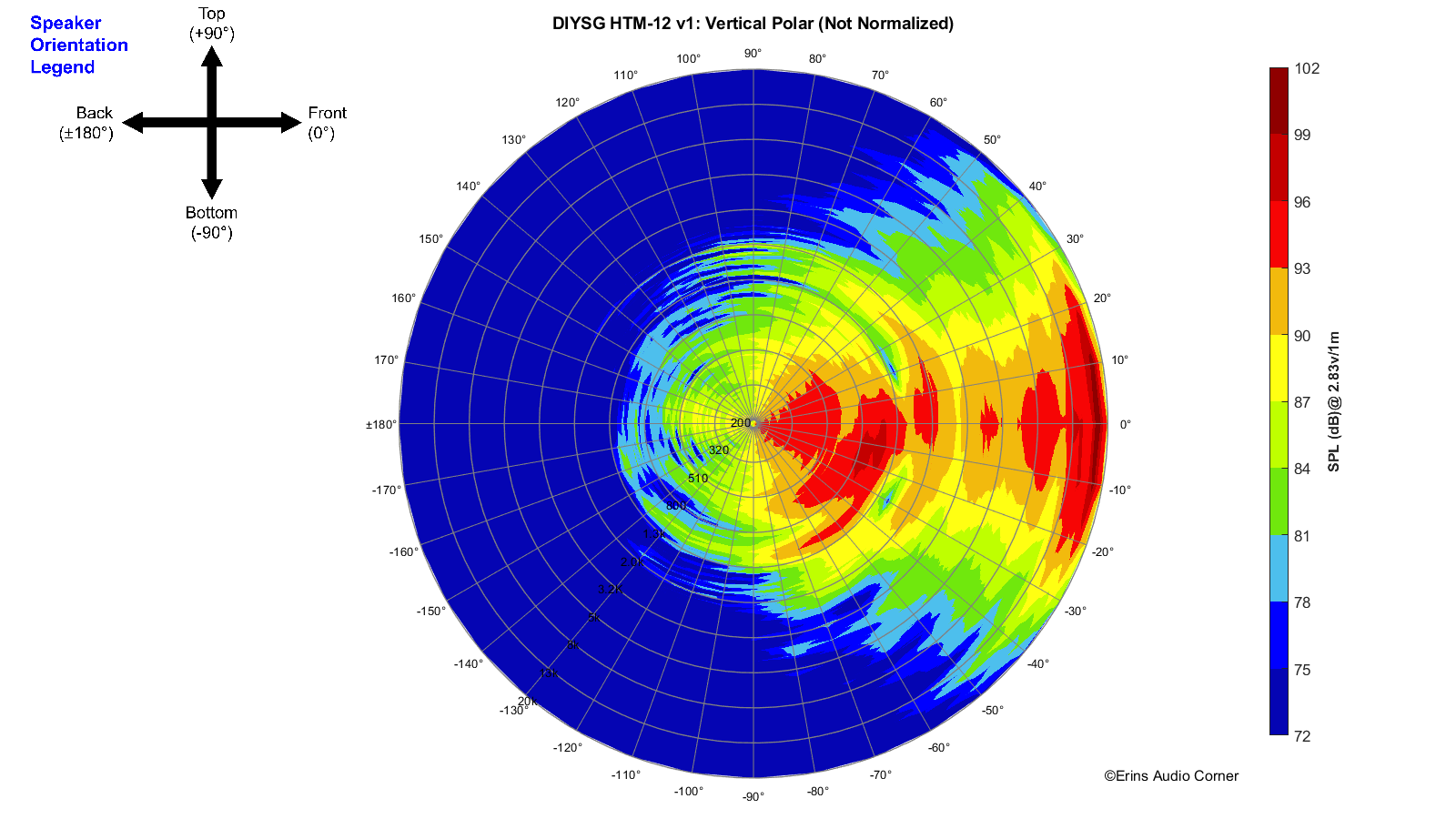
Harmonic Distortion
Harmonic Distortion at 86dB @ 1m:

Harmonic Distortion at 96dB @ 1m:

Harmonic Distortion at 102dB @ 1m:

Near-Field Response
Nearfield response of individual drive units:

Dynamic Range (Instantaneous Compression Test)
The below graphic indicates just how much SPL is lost (compression) or gained (enhancement; usually due to distortion) when the speaker is played at higher output volumes instantly via a 2.7 second logarithmic sine sweep referenced to 76dB at 1 meter. The signals are played consecutively without any additional stimulus applied. Then normalized against the 76dB result.
The tests are conducted in this fashion:
- 76dB at 1 meter (baseline; black)
- 86dB at 1 meter (red)
- 96dB at 1 meter (blue)
- 102dB at 1 meter (purple)
The purpose of this test is to illustrate how much (if at all) the output changes as a speaker’s components temperature increases (i.e., voice coils, crossover components) instantaneously.
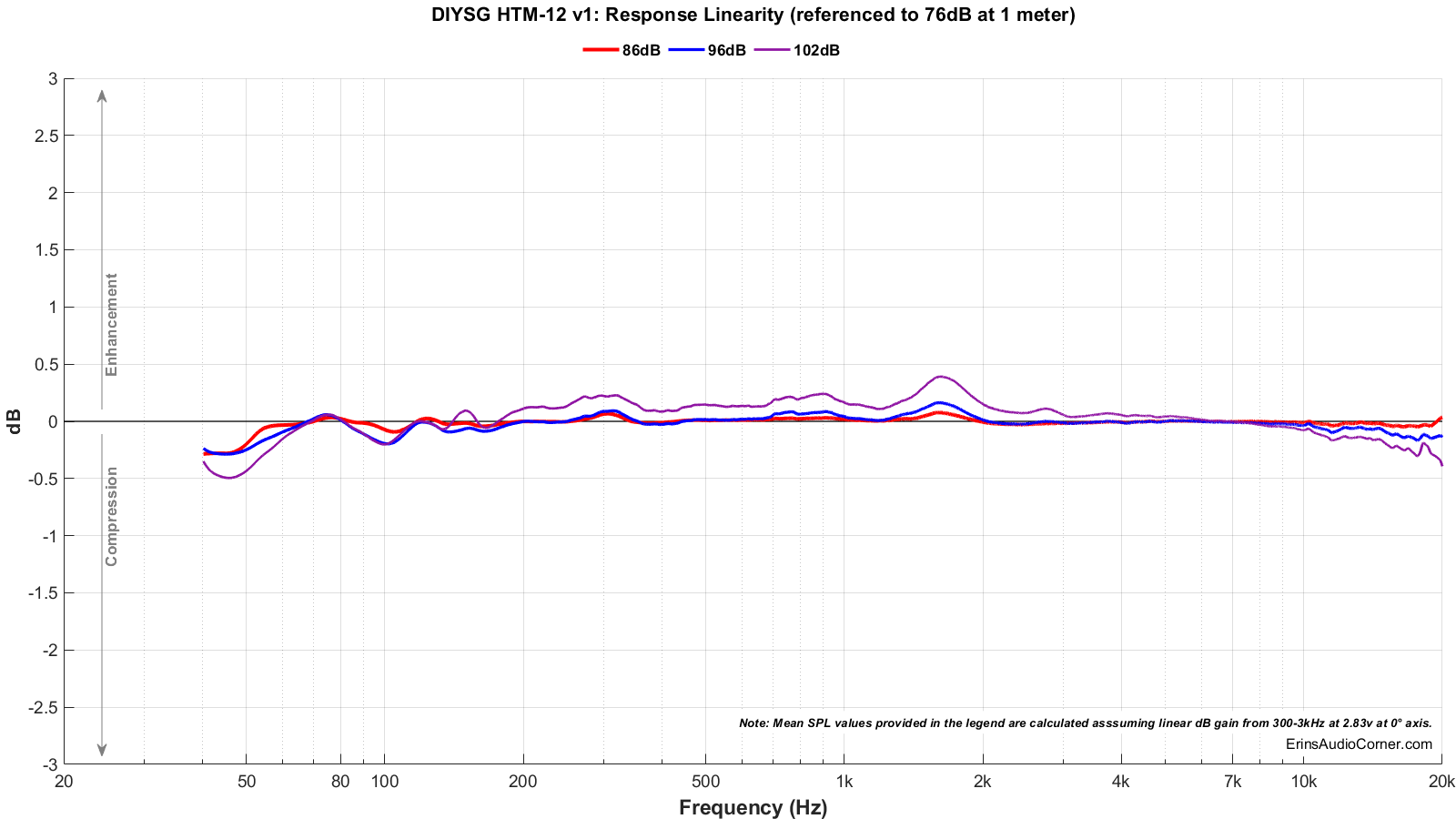
Long Term Compression Tests
The below graphics indicate how much SPL is lost or gained in the long-term as a speaker plays at the same output level for 2 minutes, in intervals. Each graphic represents a different SPL: 86dB and 96dB both at 1 meter.
The purpose of this test is to illustrate how much (if at all) the output changes as a speaker’s components temperature increases (i.e., voice coils, crossover components).
The tests are conducted in this fashion:
- “Cold” logarithmic sine sweep (no stimulus applied beforehand)
- Multitone stimulus played at desired SPL/distance for 2 minutes; intended to represent music signal
- Interim logarithmic sine sweep (no stimulus applied beforehand) (Red in graphic)
- Multitone stimulus played at desired SPL/distance for 2 minutes; intended to represent music signal
- Final logarithmic sine sweep (no stimulus applied beforehand) (Blue in graphic)
The red and blue lines represent changes in the output compared to the initial “cold” test.

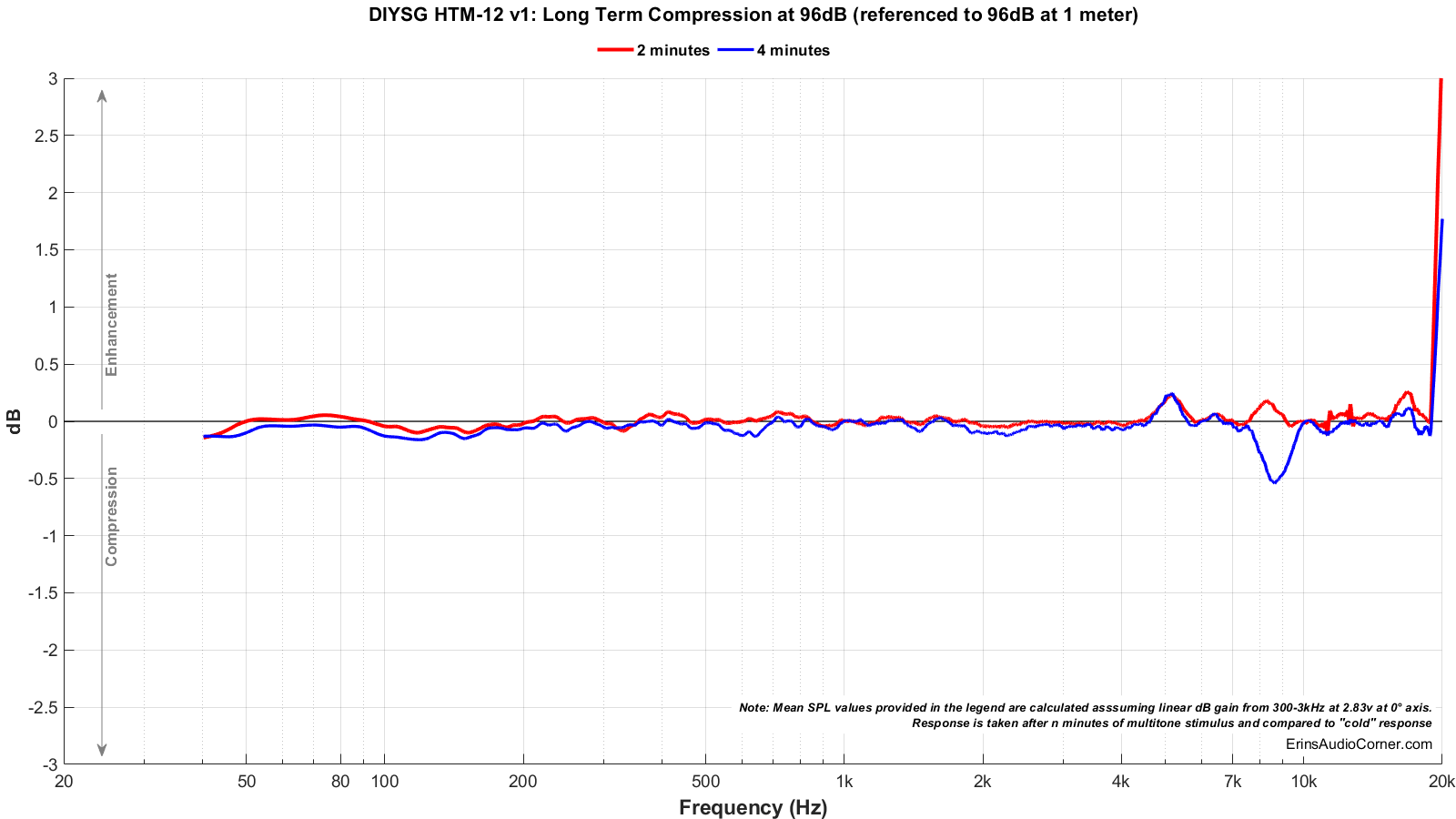
Parting / Random Thoughts
If you want to see the music I use for evaluating speakers subjectively, see my Spotify playlist.
- Subjective listening was mainly in the farfield at 3-4 meters in an open floorplan living room. Subjective listening was conducted at 80-95dB at these distances and occasionally higher. Higher volumes were done simply to test the output capability in case one wants to try to sit further away.
- Toy Soldiers - Resonant in the 150Hz region, her voice pops through the mix ~1kHz.
- Enjoy the Silence - Missing attack, vocals are a bit “behind” the mix; likely something in the 3kHz area.
- Higher Love - Missing that strong snare attack that I really like about this track.
- Soundstage drifts in width; i.e., “Magic” by The Cars has a mouth sound that should be on the left outside but instead is at two distinct spaces on the left; how does this match with the radiation pattern? Is the radiation uniform? Sounds varied. Looking back at the radiation pattern, this makes sense as you can see the radiation tends to shift in angle. For example, at 300Hz the radiation pattern is about 20° wider than at 500Hz before getting wider again at 800Hz to 1.3kHz and then narrowing another 20° above this and narrowing up until approximately 9kHz. This varying radiation pattern in my incredibly subjective opinion causes the soundstage to not remain consistent, meaning that if an instrument or vocal is at one place in the soundstage for the fundamental, it will be at a different location for the harmonic(s). YMMV.
- Sensitivity averages around 94dB @ 2.83v/1m.
- Obviously with an f3 of 78Hz and f10 of 53Hz, these speakers do need a subwoofer. Without the addition of a subwoofer you will find lack of fullness to tracks with low midbass (50-60Hz kickdrums, for example).
- Distortion and compression are incredibly low. In fact, the lowest I’ve measured to date, besting the $3000/pair Klipsch Heresy IV.
- No problem getting very, very loud in my large living room.
- Voices don’t sound natural; FR is quite varied and some intelligibility is lost due to the 3kHz suck out.
While the on-axis response is not linear, the off-axis response trends very well with the on-axis and the directivity indeces are quite linear - outside of a couple areas. This means that this speaker should do quite well once equalized to flat (or, at least, more linear).
Support / Donate
If you like what you see here and want to help me keep it going, please consider donating via the PayPal Contribute button below. Donations help me pay for new items to test, hardware, miscellaneous items and costs of the site’s server space and bandwidth. All of which I otherwise pay out of pocket. And, truthfully speaking, help me buy lunch and maybe take my wife and kid out for dinner now and again in an effort to “apologize” for spending so much time in the garage testing all these speakers. So, if you can help chip in a few bucks, know that it is very much appreciated. Alternatively, you can use the affiliate link on my site if you want to purchase these.
Alternatively, if you have a need to purchase anything through Amazon, please consider using my Amazon affiliate link below. It yields me a small commission at no additional cost to you and allows me to keep providing you with sweet data to make educated purchase decisions.
You can also join my Facebook and YouTube pages if you would like to follow along with updates.